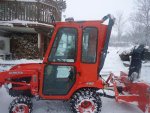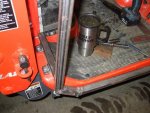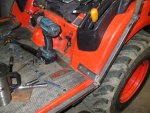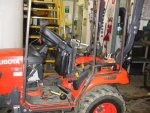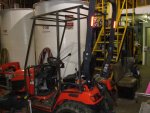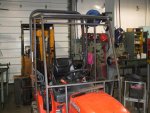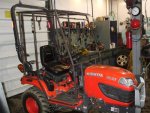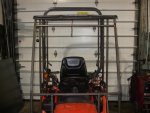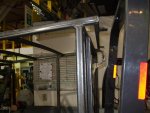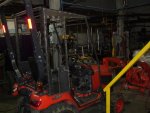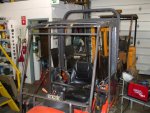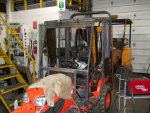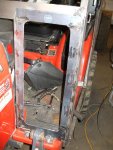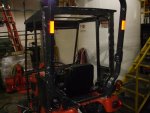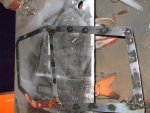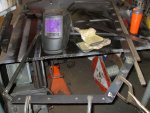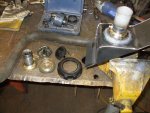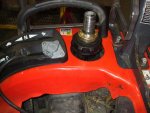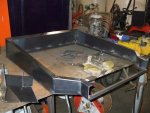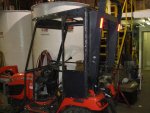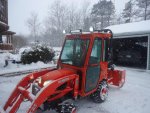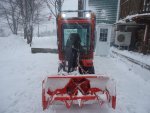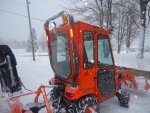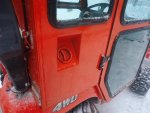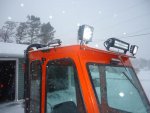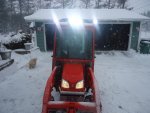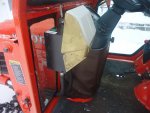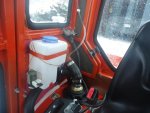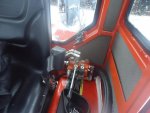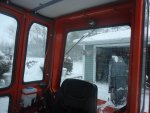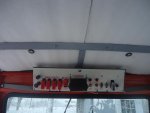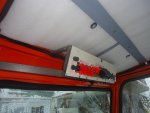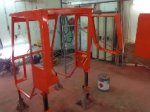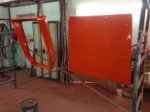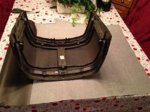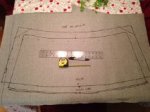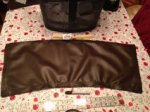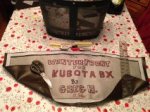OK, so I've hinted a couple times on here after I built my last two trailers that I was planning a Cab for my BX25D, so time to put my money where my mouth is. -Warning: This will be a long read. Photos following the text.
I spent a couple weeks sketching, planning, and researching cabs on-line, comparing builds, desired features, and some not-so-desired features on home built cabs and factory cabs. The finished cost of the factory cabs, landed here in Atlantic Canada was scary, esp with the falling Cdn. dollar and freight, so I bit the bullet, bought 2 X 22 ft. lengths of 1" sq. tubing, 4 lengths of 3/4" sq. tubing, and a 4' X 8' sheet of 16ga. sheet steel. I run an Asphalt Emulsion mfg. facility, and winters are dead season, so I did the build in the heated plant, where I have all cutting, grinding gear, plus cutting torches and a sweet Lincoln Mig180 wire welder, plus a big stick machine if needed for heavier work. I knew what I wanted for lighting, so when I began the build, I also tapped Amazon.ca for all the LED lighting units, Front and Rear Windshield Wiper Units, the Windshield Washers, plus scoped out E-Bay seller for the Amber LED Flashing units and the door rubber self-stick weather stripping.
Being the BackHoe model, I wanted the rear glass panel removable to be able to swivel the seat around and use the backhoe. I kept the cab height slightly lower than the ROPS, including the rear lights, and I did not need to make the roof to raise, and have lots of head room climbing into the seat for backhoe operation.
One more desired feature was to have an external Fuel Filler Neck, as it was difficult enough to raise the 5 gal. Diesel jug to the fuel cap, without having the cab door pillers in the way. Tektite Cabs had such a feature on their cabs, and knew I could build such a thing quite easily.
I decided early on, I also wanted tempered Safety Glass, set in rubber, so contacted our local Speedy Glass shop, to get particulars of what I needed to do to make it all work. They only needed 3/4" clear metal to install the rubber gasketing, and wanted a 3" radius for corners (He said use the inside of a masking tape roll as pattern). I enquired about plexiglass/lexan, they told me the tempered safety glass was cheaper than the acrylic, and albeit heavier, would not crack or scratch.
I read the many articles on the cabs, factory and homebuilts, and a common thread was the inherent noise from the 'tin-can' enclosure which amplified the engine and gear whine. With this in mind, the plan became to isolate the cab from the tractor as much as possible.
I built the cab with 6 mounting points, and am able to lift off the cab with a small hoist or in my case I had access to a forklift and a strap sling, thanks also to built-in lifting lugs on the sides, bolted through the roof to the framework, as part of the side-lights.
I probably could've/should've used only 4 mounting points, front of floor pan and rear ROPS mount, but my method balances out the weight on 6 points, being also mid-mounted at beginning of rear fenders. I have access to lots of 1/8" thick red rubber sheet gasketing at my work, and did use it between all mounting points, plus used it as my front hood dam/shield, fitting it one piece around the engine hood down the front lowers. I can reach the hood latch from inside, and simply flex the rubber to open the hood. Closing is the reverse. I also used the rubber at the rear corners where the ROPS meets the cab corners, plus along the underside of the rear removable window, with a small cut-away for my rear hydraulic hoses and the Blower Chute control cable.
I'm going to stop rambling here, and post some photos of the build, will continue with my How-I-Did-It, later.
I spent a couple weeks sketching, planning, and researching cabs on-line, comparing builds, desired features, and some not-so-desired features on home built cabs and factory cabs. The finished cost of the factory cabs, landed here in Atlantic Canada was scary, esp with the falling Cdn. dollar and freight, so I bit the bullet, bought 2 X 22 ft. lengths of 1" sq. tubing, 4 lengths of 3/4" sq. tubing, and a 4' X 8' sheet of 16ga. sheet steel. I run an Asphalt Emulsion mfg. facility, and winters are dead season, so I did the build in the heated plant, where I have all cutting, grinding gear, plus cutting torches and a sweet Lincoln Mig180 wire welder, plus a big stick machine if needed for heavier work. I knew what I wanted for lighting, so when I began the build, I also tapped Amazon.ca for all the LED lighting units, Front and Rear Windshield Wiper Units, the Windshield Washers, plus scoped out E-Bay seller for the Amber LED Flashing units and the door rubber self-stick weather stripping.
Being the BackHoe model, I wanted the rear glass panel removable to be able to swivel the seat around and use the backhoe. I kept the cab height slightly lower than the ROPS, including the rear lights, and I did not need to make the roof to raise, and have lots of head room climbing into the seat for backhoe operation.
One more desired feature was to have an external Fuel Filler Neck, as it was difficult enough to raise the 5 gal. Diesel jug to the fuel cap, without having the cab door pillers in the way. Tektite Cabs had such a feature on their cabs, and knew I could build such a thing quite easily.
I decided early on, I also wanted tempered Safety Glass, set in rubber, so contacted our local Speedy Glass shop, to get particulars of what I needed to do to make it all work. They only needed 3/4" clear metal to install the rubber gasketing, and wanted a 3" radius for corners (He said use the inside of a masking tape roll as pattern). I enquired about plexiglass/lexan, they told me the tempered safety glass was cheaper than the acrylic, and albeit heavier, would not crack or scratch.
I read the many articles on the cabs, factory and homebuilts, and a common thread was the inherent noise from the 'tin-can' enclosure which amplified the engine and gear whine. With this in mind, the plan became to isolate the cab from the tractor as much as possible.
I built the cab with 6 mounting points, and am able to lift off the cab with a small hoist or in my case I had access to a forklift and a strap sling, thanks also to built-in lifting lugs on the sides, bolted through the roof to the framework, as part of the side-lights.
I probably could've/should've used only 4 mounting points, front of floor pan and rear ROPS mount, but my method balances out the weight on 6 points, being also mid-mounted at beginning of rear fenders. I have access to lots of 1/8" thick red rubber sheet gasketing at my work, and did use it between all mounting points, plus used it as my front hood dam/shield, fitting it one piece around the engine hood down the front lowers. I can reach the hood latch from inside, and simply flex the rubber to open the hood. Closing is the reverse. I also used the rubber at the rear corners where the ROPS meets the cab corners, plus along the underside of the rear removable window, with a small cut-away for my rear hydraulic hoses and the Blower Chute control cable.
I'm going to stop rambling here, and post some photos of the build, will continue with my How-I-Did-It, later.
Attachments
-
96.8 KB Views: 1,987
-
96.8 KB Views: 1,710
-
97.4 KB Views: 1,710
-
96.9 KB Views: 1,755
-
92.4 KB Views: 1,707
Last edited:


